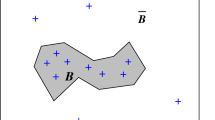Abstract
Weights-of-evidence (WofE) modeling and weighted logistic regression (WLR) are two methods of regional mineral resource estimation, which are closely related: For example, if all the map layers selected for further analysis are binary and conditionally independent of the mineral occurrences, expected WofE contrast parameters are equal to WLR coefficients except for the constant term that depends on unit area size. Although a good WofE strategy is supposed to achieve approximate conditional independence, a common problem is that the final estimated probabilities are biased. If there are N deposits in a study area and the sum of all estimated probabilities is written as S, then WofE generally results in S > N. The difference S − N can be tested for statistical significance. Although WLR yields S = N, WLR coefficients generally have relatively large variances. Recently, several methods have been developed to obtain WofE weights that either result in S = N, or become approximately unbiased. A method that has not been applied before consists of first performing WofE modeling and following this by WLR applied to the weights. This method results in modified weights with unbiased probabilities satisfying S = N. An additional advantage of this approach is that it automatically copes with missing data on some layers because weights of unit areas with missing data can be set equal to zero as is generally practiced in WofE applications. Some practical examples of application are provided.
Similar content being viewed by others
References
Agterberg, F. P., 1992, Combining indicator patterns in weights of evidence modeling for resource evaluation: Nonrenew. Resour., v. 1, no. 1, p. 35–50.
Agterberg, F. P., and Cheng, Q., 2002, Conditional independence test for weights-of-evidence modeling: Nat. Resour. Res., v. 11, no. 4, p. 249–255.
Agterberg, F. P., Bonham-Carter, G. F., and Wright, D. F., 1990, Statistical pattern integration for mineral exploration, in Gaál, G., and Merriam, D. F., eds., Computer Applications in Resource Exploration, Prediction and Assessment for Metals and Petroleum: Pergamon, Oxford, p. 1–21.
Agterberg, F. P., Bonham-Carter, G. F., Cheng, Q. M., and Wright, D. F., 1993, Weights of evidence modeling and weighted logistic regression for mineral potential mapping, in Davis, J. C., and Herzfeld, U. C., eds., Computers in Geology—25 Years of Progress: Oxford University Press, New York, p. 13–32.
Bonham-Carter, G. F., 1994, Geographic Information Systems for Geoscientists: Pergamon, Oxford, p. 398.
Bonham-Carter, G. F., Agterberg, F. P., and Wright, D. F., 1988, Integration of geological datasets for gold exploration in Nova Scotia: Photogramm. Eng. Remote Sens., v. 54, no. 11, p. 1585–1592.
Bonham-Carter, G. F., Agterberg, F. P., Cheng, Q., Behnia, P., Raines, G., and Kerswill, J., 2009, Correcting for bias in weights-of-evidence applications to assessing mineral processing: IAMG-2009 Conference Proceedings, Stanford University.
Caumon, G., Ortiz, J. M., and Rabeau, O., 2006, A comparative study of three data-driven mineral potential mapping techniques: Proceedings CD, IAMG-2006, S13-05 (4 pages).
Cheng, Q., 2008, Non-linear theory and power-law models for information integration and mineral resources quantitative assessments, in Bonham-Carter, G., and Cheng, Q., eds., Progress in Geomathematics: Springer, Heidelberg, p. 195–225.
Christensen, R., 1990, Log-Linear Models: Springer-Verlag, New York, p. 408.
Deng, M., 2009, A conditional dependence adjusted Weights of Evidence model: Nat. Resour. Res., v. 18, no. 4, p. 249–258.
Deng, M., 2010a, A spatially autocorrelated Weights of Evidence model: Nat. Resour. Res., v. 19, no. 1, p. 33–44.
Deng, M., 2010b, An ordered Weights of Evidence model for ordered discrete variables: Nat. Resour. Res., v. 19, no. 2, p. 83–89.
Journel, A. J., 2002, Combining knowledge from diverse sources: An alternative to traditional conditional independence hypothesis: Math. Geol., v. 34, no. 5, p. 573–596.
Krishnan, S., 2008, The tau model for data redundancy and information combination in earth sciences: Theory and application: Math. Geosc., v. 40, no. 6, p. 705–727.
Krishnan, S., Boucher, A., and Journel, A. G., 2004, Evaluating information redundancy through the Tau model, in Leuangthong, O., and Deutsch, eds., Geostatistics Banff 2004: Springer, Heidelberg, p. 1037–1046.
Raines, G. L., and Bonham-Carter, G., 2007, Introduction to special issue on spatial modeling: Nat. Resour. Res., v. 16, no. 2, p. 81–82.
Sawatzky, D. I., Raines, G. L., Bonham-Carter, G. F., and Looney, 2009, Spatial Data Modeller (SDM): ArcMAP 9.3 geoprocessing tools for spatial modelling using weights of evidence, logistic regression, fuzzy logic and neural networks: http://arcscripts.esri.com/details.asp/dbid=15341.
Spiegelhalter, D. J., and Knill-Jones, R. P., 1984, Statistical and knowledge-based approaches to clinical decision-support systems with an application in gastroenterology (with discussion): J. R. Stat. Soc. B, v. 147, p. 35–77.
Acknowledgments
Thanks are due to Graeme Bonham-Carter, Qiuming Cheng, and Helmut Schaeben for constructive discussions during preparation of this article.
Author information
Authors and Affiliations
Corresponding author
Additional information
An earlier version of this article was published as an extended abstract in the Proceedings of the IAMG Annual Conference held at Stanford University, August 2009.
Rights and permissions
About this article
Cite this article
Agterberg, F. A Modified Weights-of-Evidence Method for Regional Mineral Resource Estimation. Nat Resour Res 20, 95–101 (2011). https://doi.org/10.1007/s11053-011-9138-0
Received:
Accepted:
Published:
Issue Date:
DOI: https://doi.org/10.1007/s11053-011-9138-0




